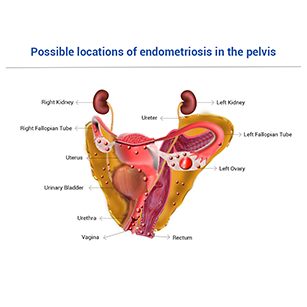Dr Salma Kayani has been formally trained in England by the Royal College of Obstetricians and Gynaecologists (RCOG) for two-and-a-half years, as a Clinical Fellow, in the medical and laparoscopic surgical treatment of Endometriosis. In addition to the above formal training, she has undertaken a 3 years’ Masters in Science (MSc) Degree with Merit in Advanced Gynaecological Endoscopy from the University of Surrey Post Graduate Medical School (UK).
Dr Salma Kayani is highly skilled and has a vast experience in the medical and laparoscopic surgical treatment of all stages of endometriosis with a very high success rate of pain relief and achievement of natural pregnancy after surgery.
Till today she has successfully treated hundreds of cases of all grades of endometriosis, nationally and internationally.
Her strength is that she removes all grades of endometriosis through Minimal Access Surgery/Keyhole Surgery. This means that she operates on the patient through a very small 5 mm cut, safely removes all the endometriosis disease and the patient goes home the next day. There is very little blood loss (only a few mls), a small invisible scar and very little pain.
In recognition of her services/contributions towards the medical and surgical treatment of endometriosis, Dr Salma Kayani is the Chair/Captain of Endometriosis of Kuwait nominated by the American Association of Laparoscopic Gynaecologists (AAGL), American College of Obstetricians and Gynaecologists (ACOG) and World Endometriosis Organization.
In May 2014, the Kuwait National Petroleum Company (KNPC) & Health, Safety and Environment Agency (HSE) of Kuwait, jointly, in recognition of Dr Salma Kayani’s skills and services, awarded her with the prestigious 7th Annual Clinical Excellence Award for providing the Best New Service (Advanced Laparoscopic Surgical Treatment for Endometriosis).
Dr Salma Kayani is considered as an international authority on the subject and is among the very few Endometriosis experts in the world.
Memberships:
Dr.(Mrs) Salma Kayani is an active member of these prestigious international Organizations/Societies for the last 12 years.
- American association of Gynecological Laparoscopists. - (AAGL)
- European Society for Gynecology Endoscopy - (ESGE)
- British Society for Gynecology Endoscopy - (BSGE)
- British and Irish Association of Robotic Gynecological Surgeons - (BIARGS)
- Society for Endometriosis and Uterine Disorders - (SEUD)
Advantages to Dr.(Mrs) Salma Kayani Patients:
By being a member of these prestigious socities and organizations, Dr (Mrs) Salma Kayani's patients can have the confidence and assurance that:
- Dr (Mrs) Salma Kayani's clinical and surgical practice is up-to-date and in accordance with the most latest international medical standards and surgical techniques being practiced in European and American hospitals.
- The care her patients receive is state of the art, most latest, evidence-based and has support and recognition of these prestigious international societies.






